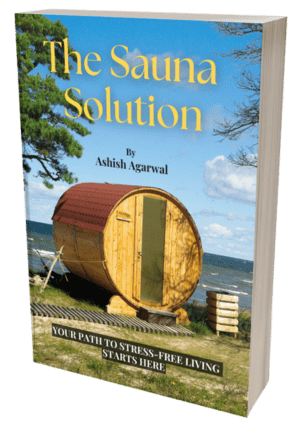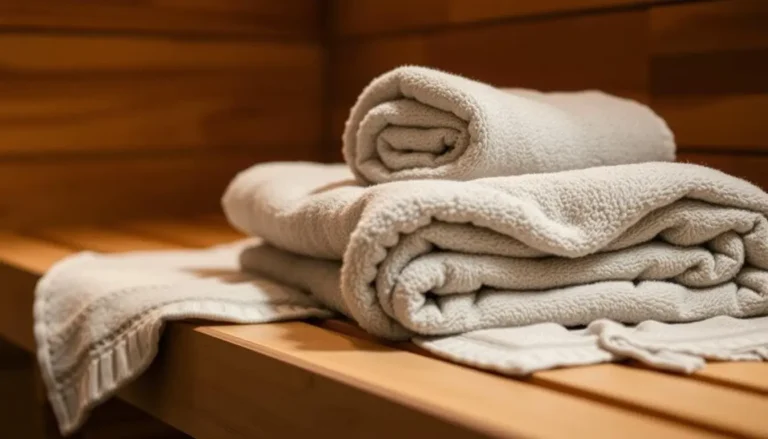DIY Indoor Sauna: Save Up to $8,000 With This 2025 Guide

Want luxurious heat therapy at home for less than half the cost of professional installation? Building your own indoor sauna could save you $5,000-$8,000 while creating a personal wellness retreat.
Studies show that using a sauna can slash your risk of sudden cardiac death by 63% – and now you can enjoy these benefits steps from your bedroom.
I’ve helped countless homeowners construct their own saunas, and I’ll walk you through every step of creating a professional-quality space. Whether you’re working with a basement, garage, or spare room, this guide covers each phase of the project – from material selection through final safety checks.
Table of Contents
Cost Analysis & Value Considerations
A DIY indoor sauna project opens up multiple paths to your personal wellness retreat. Here’s what you can expect to invest:
Basic DIY Build ($2,650-$4,300):
- Harvia M3 heater: $950-$1,600
- Cedar paneling: $800-$1,200
- Insulation/vapor barrier: $400-$600
- Electrical components: $300-$500
- Ventilation system: $200-$400
Premium DIY Build ($7,900-$11,800):
- Harvia Virta heater: $4,500-$6,800
- Premium cedar: $1,200-$1,800
- Enhanced insulation: $600-$800
- Professional electrical: $800-$1,200
- Advanced ventilation: $800-$1,200
Smart builders can trim costs without compromising quality. Nordic Spruce offers an excellent alternative to cedar, saving up to 35% on materials. Buying lumber in bulk typically nets a 10-15% discount. Starting with basic ventilation leaves room for future upgrades while keeping initial costs manageable.
The long-term value proposition makes this investment even more attractive. Your sauna will add approximately 2-3% to your property value while operating costs remain reasonable at $0.35-$0.65 per hour. With annual maintenance running $150-300 and a lifespan of 15-20 years, it’s a sound investment in both wellness and property value.
Related: How Much Does a Sauna Cost in 2025

Planning & Space Requirements
Planning your sauna starts with finding the perfect spot in your home. Your space needs a minimum of 4×4 feet for a compact sauna, though 6×8 feet creates a more comfortable experience. Remember to factor in an extra 12-18 inches around the perimeter for maintenance access.
Room selection criteria extends beyond just size. Your chosen location needs:
- Access to 240V electrical service
- Proper ventilation possibilities
- Protection from water damage
- Level flooring that can support the structure
Consider ceiling height carefully – you’ll need at least 7 feet to ensure proper heat stratification and comfortable seating. The ideal layout places benches along the longest wall, with the heater mounted on the opposite wall from the door.
Before starting construction, check local building codes and permit requirements. Most jurisdictions require electrical permits, and some mandate specific safety features like GFCI protection and emergency shutoffs.
Basement-Specific Considerations
Creating a sauna in your basement demands specialized attention to moisture and foundation details. Start with a thorough assessment – your foundation must be bone-dry and free from any existing water issues or mold growth. A level concrete slab, a minimum of 4 inches thick, provides the stable base your sauna requires.
Below-grade installations face unique moisture challenges. Install a continuous 6-mil polyethylene moisture barrier beneath wood subfloors, sealing all seams carefully. While 7 feet remains the minimum ceiling height for any sauna, basement installations often deal with lower ceilings. In these cases, consider a Saunum heater with an air equalizer – these specialized units distribute heat more evenly throughout the space, compensating for height limitations.
Basement ventilation requires a robust two-part system to combat the naturally higher humidity:
- A powered exhaust fan in the ceiling opposite your heater
- Fresh air intake vent near the heater’s base
- Optional dehumidification system for humid climates
Essential Materials & Equipment
Your sauna build requires specific materials rated for high-heat environments.
Required Tools
- Drill with assorted bits
- Circular saw
- Air compressor and finish nailer
- Table saw
- Heavy-duty stapler
- Standard hand tools (hammer, measuring tape, level)
Core Materials
- Lumber: Western Red Cedar or Nordic Spruce for walls/benches
- Insulation: R-13 mineral wool for walls, R-19 for ceiling
- Vapor barrier: 6-mil foil-faced polyethylene
- Heater: 4.5-9kW electric unit based on room size
- Electrical: 8/2 or 10/2 gauge copper wire
- Ventilation: Fan unit plus ducting
- Fixtures: Heat-resistant lighting and controls

Construction Process: Framing & Electrical
Start by mapping your walls using 2×6 SPF lumber spaced 16 inches in the center. Double up your door header using 2x8s with a 1/2-inch plywood spacer. Add 45-degree metal straps at corners for extra stability.
Next comes electrical prep:
- Run 240V service for your heater (8/2 gauge wire for units over 8kW)
- Install separate 120V circuits for lights and fans
- Use copper wiring rated for high heat (minimum 90°C/194°F)
- Place GFCI protection on all circuits within 1.5m of the sauna
- Mount vapor-proof electrical boxes
Install recessed LED lighting rated for wet locations. Under-bench LED strips create ambiance and improve safety. Place your heater controls outside the sauna room for easy access.
Insulation & Vapor Barrier System
Proper insulation makes the difference between efficient heating and wasted energy. Start with mineral wool insulation – it resists both fire and moisture while providing excellent R-values. Pack R-13 batts into wall cavities and R-19 into the ceiling space. Fill gaps tightly but avoid compression, which reduces effectiveness.
The vapor barrier serves as your moisture defense line. Apply 6-mil foil-faced polyethylene over all insulated surfaces. Overlap seams by 4 inches minimum, securing with staples every 6 inches. Seal all joints with foil tape rated for high temperatures. Pay extra attention around electrical boxes and vent openings – use high-temp silicone to create watertight seals.
Ventilation & Temperature Control
Your sauna needs specific airflow patterns for safe operation. Place intake and exhaust vents following these specifications:
Match your ventilation to your sauna size:
- Small saunas (4×4 to 5×6): 30 CFM intake/50 CFM exhaust
- Medium saunas (5×7 to 6×8): 40 CFM intake/60 CFM exhaust
- Large saunas (7×8+): 50 CFM intake/75 CFM exhaust
Control your temperature accurately with a digital thermostat mounted 6 inches below ceiling level. Set maximum temperature limits to 212°F (100°C). Your heater should include an automatic shutoff timer limiting sessions to 90 minutes for safety.
Wall Paneling & Bench Construction
Western Red Cedar stands as the premium choice for sauna walls, though Nordic Spruce offers a budget-friendly alternative. Start paneling from the bottom up, using tongue-and-groove boards secured with stainless steel nails. Keep a 1/4-inch gap at the floor and ceiling for wood expansion.
Your benches need careful planning – they’ll support full body weight at high temperatures. Build the upper bench 36 inches from the floor, with the lower bench at 18 inches. Always check your heater’s installation manual for required bench clearances – typically 3-4 feet minimum from the heater. Position the top bench where temperatures reach optimal levels.
Space your support framing 12 inches apart, using 2×4 cedar for strength. Round all edges and corners with a 1/4-inch radius for comfort and safety.
🔍 Pro tip: Pre-drill all bench screws to prevent splitting, and use stainless steel fasteners rated for high-temperature environments.
Related: Best Wood for Sauna

Customization & Comfort Features
Transform your basic sauna into a luxury retreat through strategic customization:
Essential Comfort Elements:
- Ergonomic bench design with curved backrests
- Anatomically shaped seats for longer sessions
- Built-in storage beneath the lower bench
- Wall-mounted hooks near the door for robes and towels
Entertainment & Ambiance:
- High-heat-rated Bluetooth speakers
- External control panel for music and lighting
- Sound-dampening wall design
- LED lighting with customizable colors
- Cedar oil diffuser system
- Himalayan salt blocks for air purification
- Essential oil dispensers
- Steam-infusion rocks
Premium upgrades like heated floor tiles, adjustable backrests, and ergonomic foot platforms can elevate the experience further. Each addition should balance luxury with practicality, creating your ideal wellness space.
Related: Best Sauna Accessories
Safety Features & Final Setup
Safety starts with proper heater placement. Mount electric heaters 6-12 inches from walls, following manufacturer clearance guidelines. Install a protective barrier around the heater using non-combustible materials like cement board.
Essential safety elements include:
- Emergency shutoff switch within sight of heater
- Non-locking door that swings outward
- Temperature sensor 6 inches below ceiling
- Carbon monoxide detector for wood-heated saunas
- Fire extinguisher mounted near entrance
Test every component before first use. Run your heater through several heat cycles, checking for proper temperature control and ventilation function. Look for any signs of moisture accumulation during cooldown periods.
Maintenance & Long-Term Care
Regular maintenance keeps your sauna performing safely year after year. Clean benches and floors weekly with a mild soap solution. Prop the door open and run ventilation fans for 30 minutes after each session to dry the space completely.
Monthly checks should include:
- Testing GFCI outlets and emergency shutoffs
- Inspecting heater elements and connections
- Checking ventilation systems for proper operation
- Examining wood surfaces for moisture damage
- Verifying temperature control accuracy
Apply cedar oil to benches every 6 months to maintain wood quality. Replace sauna stones annually or sooner if they show signs of cracking.
Related:
How to Clean a Sauna
How to Clean Sauna Wood

Conclusion
Building your DIY indoor sauna brings professional-grade wellness benefits at a fraction of the retail cost. While the project requires careful attention to detail, the investment pays off through years of heat therapy sessions right at home.
Remember to prioritize safety in your sauna design and construction. Pull proper permits, follow electrical codes, and never rush installation steps. Your reward? A personal sanctuary that can last decades while potentially saving you $5,000-$8,000 compared to a professional installation.
FAQs
What is the 200 rule sauna?
The 200 rule states that a sauna’s cubic foot volume multiplied by watts per cubic foot should equal 200. Example: A 320-cubic-foot sauna requires a 6.4kW heater (320 × 20 = 6,400 watts). This rule ensures proper heating capacity for your space.
Do home saunas smell?
New cedar saunas emit a natural wood scent for 2-3 weeks. Properly ventilated and maintained saunas develop no unpleasant odors. Regular cleaning and drying after use prevents mildew smells. Cedar’s natural antimicrobial properties help maintain freshness.
What should a sauna floor be made of?
Concrete, ceramic tile, or vinyl flooring works best for sauna floors. These materials resist moisture, clean easily, and withstand high temperatures. Wood flooring requires special treatment and more maintenance. Tile offers the best combination of durability and drainage.
How sanitary are dry saunas?
Dry saunas remain sanitary when properly maintained. High heat kills most bacteria. Weekly cleaning with an antimicrobial solution ensures hygiene. Using personal towels prevents direct contact with benches. Regular ventilation removes moisture that could promote bacterial growth.
Do saunas need their own circuit?
Yes, saunas require dedicated electrical circuits. Electric heaters need a 240V circuit rated 30-40 amps, depending on heater size. Lighting and ventilation fans need separate 120V circuits. All circuits must have GFCI protection and meet local electrical codes.

“Become a Sauna Expert Overnight!”
Grab Your “FREE” Sauna E-book NOW!
Get your hands on the ultimate sauna manual. From history to DIY setups, our free guide has it all.

As a Chartered Accountant turned sauna enthusiast, I bring a unique blend of analytical skills and hands-on experience to the world of heat therapy. With over a decade dedicated to researching and testing sauna products and practices, I’ve developed a deep understanding of this field. A the founder of HomeInDepth.com, I provide reliable, easy-to-understand information on all aspects of saunas. My goal is to guide you through every step of your sauna journey, offering meticulously researched, unbiased advice to help you make informed decisions and create your perfect sauna experience. I’m always happy to hear from sauna lovers like you—feel free to leave questions or share your own tips in the comments below so we can learn together. Contact me on:






